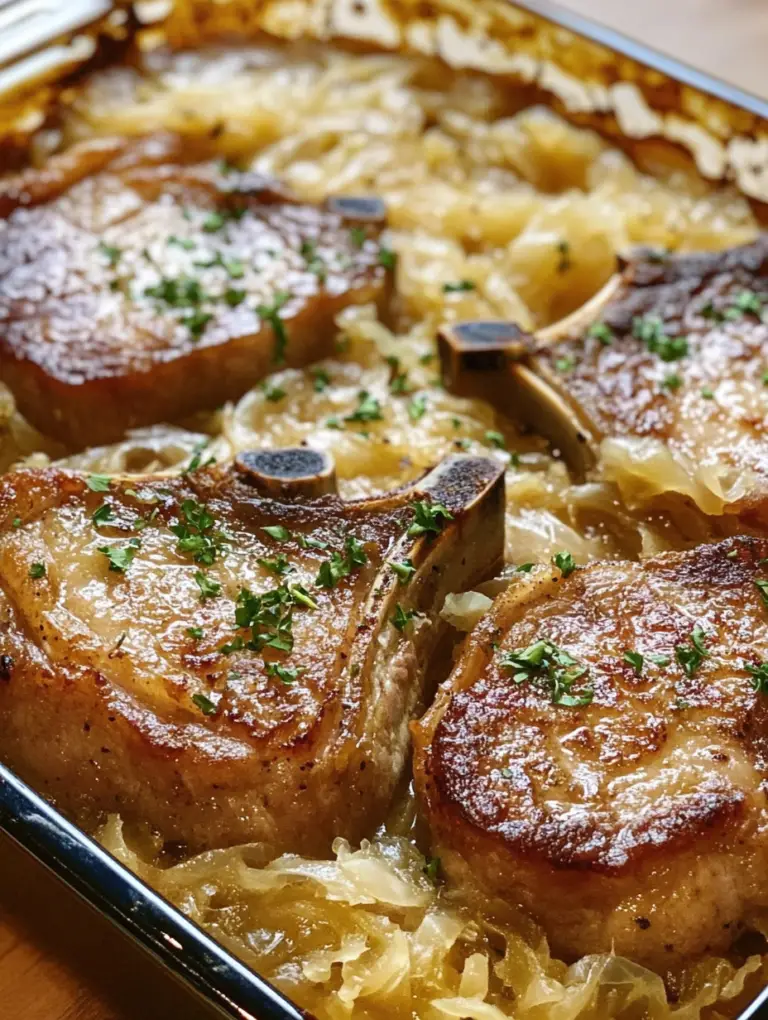 Pin it
Pin it
This German-inspired pork chop and sauerkraut casserole brings together layers of savory pork, tangy kraut, and sweet apples in one hearty skillet dish. The flavors meld beautifully during baking, creating a comforting meal that feels rustic yet elegant enough for a cozy dinner for two.
I discovered this recipe during my exploration of German cooking and it quickly became my go-to weekend dinner. Something magical happens when the pork juices mingle with the sauerkraut and potatoes, creating a dish that's greater than the sum of its parts.
Ingredients
- Bone-in pork chops: these retain moisture better than boneless and contribute more flavor to the dish
- Kosher salt: enhances all the flavors without being harsh like table salt
- Black pepper: adds a gentle warmth that complements the pork beautifully
- Unsalted butter: creates a better sear on the pork and lets you control the saltiness
- Yellow onion: becomes deliciously sweet when sautéed, balancing the tangy sauerkraut
- Granny Smith apple: the tartness cuts through the rich pork while adding natural sweetness
- Caraway seeds: these tiny powerhouses add an authentic German flavor that pairs perfectly with sauerkraut
- Russet potatoes: their starchy nature helps absorb the flavorful cooking liquids
- Refrigerated sauerkraut: fresher and less harsh than canned versions
- Low-sodium chicken broth: creates steam for cooking while adding depth without making the dish too salty
- Fresh parsley: adds a pop of color and fresh flavor to finish the dish
Step-by-Step Instructions
- Prepare the pork:
- Season the dried pork chops thoroughly with salt and pepper on both sides. Getting a good sear requires dry meat, so take the time to pat them completely dry with paper towels before seasoning.
- Create the flavor base:
- Melt butter in your skillet until it foams slightly but doesn’t brown. Sear the pork chops until they develop a deep golden crust, about 3-4 minutes per side. The chops will finish cooking in the oven, so focus on color now rather than doneness.
- Develop aromatic elements:
- After removing the pork, add onions, apples and caraway seeds to the same pan. The residual fat will coat these ingredients, infusing them with pork flavor. Sauté just until the onions become translucent and begin to soften. The apples should still have some firmness.
- Create the foundation layer:
- Arrange potato slices in an overlapping circular pattern on the bottom of the pan. This creates a sturdy base that will soak up flavors while cooking. Season this layer with salt and pepper to ensure every element of the dish is properly seasoned.
- Build the flavor layers:
- Add half the onion-apple mixture over the potatoes, spreading it evenly. The sauerkraut goes next, forming the tangy middle layer of the casserole. Top with remaining onion-apple mixture to create sweet pockets throughout the dish.
- Complete the composition:
- Nestle the seared pork chops into the top layer, making slight depressions so they sit partially submerged. Pour broth evenly over everything, allowing it to seep through the layers.
- Gentle oven cooking:
- Cover tightly with foil to trap steam and transfer to the oven. The slow baking process allows flavors to meld while tenderizing the pork and potatoes. The pork is done when it reaches 145°F internally.
- Rest before serving:
- Let the casserole rest covered for 10 minutes after removing from the oven. This allows juices to redistribute throughout the meat and helps the layers set up slightly for easier serving.
This dish brings back memories of my grandmother's kitchen, where she would make a similar casserole on cold winter evenings. The caraway seeds are my favorite element because they transform the dish from ordinary to authentically European with their distinctive fragrance and flavor.
Make-Ahead Options
This casserole can be fully assembled up to the baking stage and refrigerated overnight. Simply add an extra 10-15 minutes to the baking time when cooking from cold. The flavors actually improve with some time to meld, making this an excellent dish to prepare in advance for easy entertaining.
Smart Substitutions
If sauerkraut seems too intense for your taste, try mixing it with an equal amount of shredded fresh cabbage. The fresh cabbage will mellow the tanginess while still providing authentic flavor. For a sweeter version, substitute a Honeycrisp apple for the Granny Smith. Looking to lighten the dish? Turkey cutlets work surprisingly well in place of pork chops.
Serving Suggestions
This rustic casserole pairs beautifully with a simple green salad dressed with a mustard vinaigrette. A cold German beer or dry Riesling complements the flavors perfectly. For a complete German-inspired meal, serve with braised red cabbage on the side and finish with a slice of apple strudel for dessert.
Historical Context
This dish represents the practical cooking style of German immigrants who settled across America. The combination of pork, potatoes, and preserved cabbage provided substantial nutrition during winter months when fresh produce was scarce. What began as necessity evolved into beloved comfort food that carries cultural heritage through generations.
Frequently Asked Questions
- → Can I use boneless pork chops instead of bone-in?
Yes, boneless pork chops can be used. However, bone-in chops add extra flavor and moisture. Adjust cooking time slightly as boneless chops may cook faster.
- → What type of sauerkraut works best for this dish?
Refrigerated sauerkraut is recommended for its fresh flavor and texture. Be sure to drain and rinse it before layering in the skillet.
- → How should I store leftovers?
Store leftover casserole in an airtight container in the refrigerator for up to 4 days. Reheat individual portions in the microwave or oven until warmed through.
- → Can I substitute russet potatoes with another variety?
Yes, Yukon Gold potatoes are a good alternative. They have a creamy texture and hold their shape well during baking.
- → What is the purpose of caraway seeds in this dish?
Caraway seeds add a subtle, earthy flavor that complements the tangy sauerkraut and sweet apple. You can omit them if preferred, but they enhance the dish’s flavor profile.
- → What other garnishes can I use besides parsley?
Dill or chives are great alternatives to parsley and add fresh, herbaceous notes to the finished dish.
